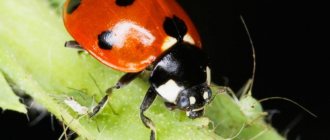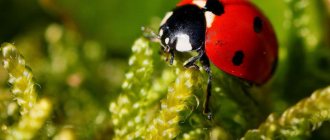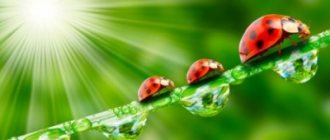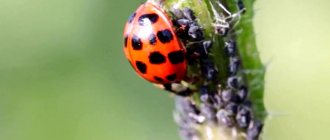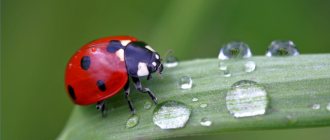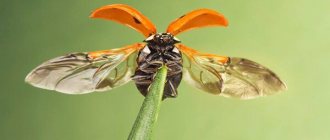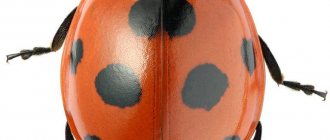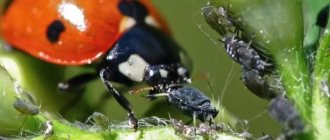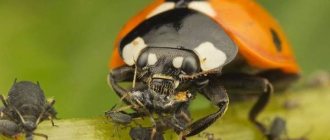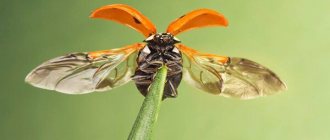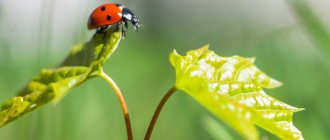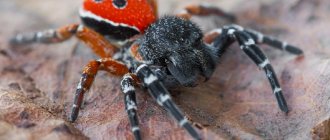Beetles from the ladybird family are clearly visible on leaves, flowers and grass. Their convex red and black bodies flash among the greenery of parks, gardens and vegetable gardens. The insect's attractive coloration is actually a warning. In case of danger, the beetle releases a poisonous liquid. It is not harmful to humans, and birds do not risk hunting small bugs. Attentive fauna lovers will notice that the pattern on the back of ladybugs differs in the number of dots. The number of black spots on the elytra ranges from 2 to 28. The seven-spotted ladybug is the most common species that is found in parks, fields and gardens.
Development
Just a beetle bursting out of its pupa
Adult beetles overwinter in protected areas near fields, where they feed and reproduce. In the spring, newly emerged beetles begin to feed on aphids before they begin to lay eggs. In a season of one to three months (spring and early summer), the female lays from 200 to 1000 eggs. Eggs of relatively large sizes (0.8-1.2 mm long) are usually laid near prey, in small piles (from 25 to 85 pieces) in protected places on leaves or twigs.
A larva from one millimeter grows in 10-30 days to 4-8 mm in length, depending on the abundance of prey - aphids. The larva can rise to a height of up to 12 meters, just like their prey. Larva of the fourth (last) instar, 8–10 mm long. The cow spends up to 12 days in the pupal stage of development, depending on the ambient temperature. A developed adult beetle reaches 5-8 mm in length.
In the northeastern United States, the ladybug produces two generations per year. Development from egg to adult may take only two or three weeks. The peak population of adults occurs in the middle and end of summer. The lifespan of adults ranges from several weeks to two to three months, depending on habitat, food availability and time of year.
28-point trouble of the 28th region
How to deal with a garden pest - the 28-spot ladybug
There is no need to describe the appearance of the 28-spotted ladybird (or epilyachna), these yellow-orange spotted beetles are known to both old and young from Blagoveshchensk to Tynda. The habitat of epilyachna is very wide - Khabarovsk and Primorsky territories, the south of Sakhalin Island and the southern Kuril Islands, northern Japan, North-East China. She is a native of the Far East.
Epilyakhna in the Amur region produces only one generation per summer. Having overwintered under the forest floor on forest edges, under heaps of plant residues in the fields, or even right in the top layer of soil, its beetles come out to feed in mid-May - early June. The winter hardiness of epilyachna is very high, its beetles do not die at temperatures down to –45 ° C, mass death of the ladybird is observed only in winters with little snow and very frosty. Unfortunately, the winters of 2009/2010 and 2010/2011 were rich in snowfall, which can explain the extremely high surge in its numbers in 2010–2011. The winter of 2011-2012, fortunately for farmers, had little snow, so in the summer of 2012 there will be much less epilyakhna than in previous years, and in a number of areas it will be possible to completely abandon the fight against it.
However, there is no need to calm down completely - at the beginning of June, epilyakhna already appeared, although in much smaller numbers in the gardens of Amur residents, and another battle with it, unfortunately, cannot be avoided. The main crop affected by epilyachna is potatoes. If there are no potatoes, epilyakhna will gladly eat the leaves of peppers, tomatoes, eggplants, cucumbers, pumpkins, other melons, corn, and soybeans. Due to the fact that it overwinters mainly under the forest floor, the ladybug causes the main damage to potatoes in wooded areas. There is little of it in the steppe regions of the region, although in recent years there has been a tendency for its numbers to increase there too.
When feeding, the 28-spot ladybird beetles eat away the leaf plate without touching the veins, in other words, they skeletonize the leaves. Such damaged leaves quickly turn yellow and fall off. In addition to destroying leaves, epilyachnas spread dangerous potato viruses, increasing the damage. As a result, the potato yield is reduced by 10-100%, and the starch content in the tubers also decreases. Having eaten young potato leaves, epilyachna females begin to lay eggs from June to mid-August.
The cow's fertility is very high - some heroine females lay up to 2 thousand eggs. The eggs hatch into larvae - the so-called "hedgehogs" - light yellow, round, up to 6 mm long, with rows of black spines - needles, which, however, are not capable of pricking anyone, since they are very soft. Throughout their entire life span—about one month—the larvae intensively eat leaves, also skeletonizing them. Thus, in the 28-spot ladybird, both beetles and larvae are harmful. The larvae then pupate and develop into young beetles. Young beetles, before going to winter quarters, feed intensively, and this fattening of winter fat occurs from mid-August until the first cold weather (mid-September).
When to treat
The first chemical treatment of potatoes should be carried out no earlier than July 5-10. Let the cow eat the leaves with impunity until this date. The growth of potato tops will still outstrip the loss from the pest. The second treatment should be scheduled for July 20-25. An indicator that the potatoes need to be processed again will be insects that appear again on the plants. The first time you can treat the potatoes, for example, with Aktara, the second treatment you can carry out, for example, with Komandor or Fitoverm, with another active ingredient. After this, only two more treatments of potatoes will be possible, but only with biological products (Fitoverm or Iskra-Bio); a chemical preparation cannot be used a third time.
Chemicals
Commander (active ingredient imidacloprid), Iskra Zolotaya (imidacloprid), Aktara (thiamethoxam). If you didn’t find these drugs, try Qi-Alpha (active ingredient alpha-cypermethrin), Lightning (lambda-cyhalothrin). Such preparations protect potatoes from the 28-spotted ladybird for no more than 2-3 weeks.
Biological drugs
Fitoverm (active ingredient aversectin C), Iskra-Bio (avertin N). These drugs kill insects with waste products of microorganisms and are therefore harmless to humans. During the season, no more than two treatments can be carried out with biological products. Their main disadvantage is that they are easily removed from the leaves of treated plants by rain or heavy dew, as well as less effective compared to chemical preparations. Therefore, plants are treated with biological products in dry, clear and windless weather, when precipitation is unlikely in the first 8-10 hours after treatment. Biological products should be used if your gardening products will be consumed by children, the elderly or people with weakened bodies.
Potatoes will be saved by chemical treatment
The main method of combating the 28-spot ladybird is chemical. It can also be recommended not to place potato plantings near forested areas, since in the Amur region, for example in Blagoveshchensk, Ivanovo and other steppe regions, there are significant undeveloped areas of land suitable for gardening. Grow potatoes there and you won't need chemicals. The chemical method allows you to radically get rid of the pest, at least for at least two weeks after spraying, potato plantings are freed from the 28-point yoke. But when using chemical treatments, in order for the grown potatoes to be safe for health, one must be guided by the following principles, which are equally valid for potatoes and other vegetable and fruit crops:
In the conditions of the Amur region, the processing time must be selected so that at least 30 days must pass from the date of the last treatment to harvest. This is the so-called waiting period. In most instructions for use of the drug, this period is set at 10-25 days. In the Amur region, summer is much colder than in European Russia, where the drugs sold were tested, so our drugs decompose more slowly and the period of their complete decomposition in plants is increased. After 30 days of waiting, the treated fruits will be safe.
It is necessary to strictly follow the dosage of the drug according to the attached instructions; in no case should you overestimate the recommended application rate, but also not underestimate it. Only when using the recommended dosage, residual amounts of the drug in the product will not harm you. Do not use expired or expired medications - you will add chemicals, but there will be no benefit.
If you are planning more than one pest control treatment per season, carry out them only with different preparations with different active ingredients. This will help prevent the emergence of drug-resistant insect pests.
To avoid the accumulation of harmful substances in products in the Amur Region, it is strictly not recommended to carry out more than two chemical treatments of vegetable and fruit crops per season.
To avoid the death of bees, crops should not be chemically treated during flowering, only before or after flowering.
Try not to fight pests alone, persuade the owners of neighboring plots to carry out the same treatments, then the death of pests will be maximum.
Observe safety precautions when working with preparations; it is safest to prepare the preparation and treat plants with it in a regular gas mask or RPG respirator, which can be purchased at a specialized store that sells work clothing. Cotton gauze and fabric bandages are not able to protect your respiratory organs from chemicals. Try not to get the drug on your skin; work in clothing that completely covers your body. Dispose of the used container and remaining solution strictly according to the instructions included with the drug.
The main crop affected by epilyachna is potatoes. If there are no potatoes, epilyakhna will gladly eat the leaves of peppers, tomatoes, eggplants, cucumbers, pumpkins, other melons, corn, and soybeans.
Age category of materials: 18+
k.s.-kh. n, Pavel Zhirnov, senior state inspector of MRO No. 8 of the Rosselkhoznadzor department for the Trans-Baikal Territory and the Amur Region
Source
Varieties, their names, descriptions and photos
Below is a description of what ladybugs are, a detailed description of the most interesting varieties; You will also be able to see their photos, including close-up photos.
Point-to-point
The body length of the two-spot ladybug reaches about 5 mm. The color is dark red with two parallel black dots on the back (hence the characteristic name). The body has an oblong-oval, moderately convex shape.
The head of light-colored individuals is black, with two large irregularly shaped spots (near the eyes). Dark bugs have a completely black head.
Seven-point
The seven-spotted ladybird is one of the most common species in Europe. The body size is about 8 mm. The color is red, and there are 3 black spots on the sides. The seventh spot is located near the head.
Twelve-point
The twelve-spotted ladybird reaches 6 mm in length. It has a red or pink color. There are 6 black dots on each elytra. The insect lives primarily in North America and feeds on pollen from agricultural plants.
Thirteen-point
The thirteen-spotted ladybird has 13 spots on its surface. Color - red-brown or brick. In this case, some spots may merge with each other. The insect is common in Europe, Asia and North America.
Asian
The Asian ladybird or Harlequin reaches a length of 7 mm. It is either yellow-black or black-orange in color. The insect lives in Asia and feeds on aphids.
Note! This species is characterized by the greatest gluttony, therefore it is specially cultivated in Europe and North America to combat agricultural pests.
Ocellated
The ocellated ladybug is considered one of the largest and reaches a length of approximately 1 cm. The color is red or yellow. In this case, each of the spots is surrounded by a lighter halo. There are 20 such “eyes” on the back of the insect.
Pointless
The spotless ladybird is one of the rarest species, characterized by a complete absence of dark spots. The body of the insect is red or brown in color and covered with barely noticeable fibers. The insect reaches several millimeters in length.
Blue
The blue cow is the most unusual representative of this family. A distinctive feature of the insect is the blue color of the elytra with a characteristic metallic sheen. Dark spots on the back are absent (or simply not visible, because they merge with the dark blue color).
It lives in the eastern part of Australia, as well as in New Zealand. The insect feeds mainly on aphids. The body size does not exceed 4 mm.
Development
Just a beetle bursting out of its pupa
Adult beetles overwinter in protected areas near fields, where they feed and reproduce. In the spring, newly emerged beetles begin to feed on aphids before they begin to lay eggs. In a season of one to three months (spring and early summer), the female lays from 200 to 1000 eggs. Eggs of relatively large sizes (0.8-1.2 mm long) are usually laid near prey, in small piles (from 25 to 85 pieces) in protected places on leaves or twigs.
A larva from one millimeter grows in 10-30 days to 4-8 mm in length, depending on the abundance of prey - aphids. The larva can rise to a height of up to 12 meters, just like their prey. Larva of the fourth (last) instar, 8–10 mm long. The cow spends up to 12 days in the pupal stage of development, depending on the ambient temperature. A developed adult beetle reaches 5-8 mm in length.
In the northeastern United States, the ladybug produces two generations per year. Development from egg to adult may take only two or three weeks. The peak population of adults occurs in the middle and end of summer. The lifespan of adults ranges from several weeks to two to three months, depending on habitat, food availability and time of year.
Lifestyle and reproduction
Insects live separately. They gather in groups only during the breeding and wintering periods. The mating period of ladybugs occurs in late spring and early summer.
It is important for the female to have a sufficient supply of nutrients necessary for the formation of offspring. If she hasn't eaten enough, she avoids mating. The male searches for a partner by secreting pheromones
The male searches for a partner by secreting pheromones.
The fertilized female lays eggs on the underside of the leaves. The location is chosen close to the aphid colony. The eggs are orange and elongated. Each clutch contains up to 50 pieces. The eggs are quite large, 1.2 mm in length, and are fixed in a vertical position. In total, the female lays 250-1000 eggs during her life.
Eggs of Coccinellaseptempunctata
The development time of the embryo depends on the temperature - at 15° it is 4 days, at 30° it is 2 days. The size of the larvae at birth is only 1 mm. Its first food is egg shells and dead embryos. Young larvae suck liquid from the aphids. As they mature, they eat their prey whole. After a month of active feeding, it grows to a length of 8-10 mm.
Coccinellaseptempunctata larva
The elongated, segmented body is dark gray. The head is yellow, there are yellow spots on the sides of the chest and abdomen. The body of the larva is covered with growths ending in black hairs. Movable limbs provide mobility. The voracious larva actively hunts aphids and eats their eggs. The development period includes a change of four instars and three molts. Then comes the pupal stage.
Before pupation, the fourth instar larva fasts for a day. It attaches to the plant with the tip of its abdomen and pupates. The pupa is orange with black spots. The stage takes 8-12 days; at high temperatures it passes faster. The shell of the pupa is torn along the back. The young seven-spotted ladybug emerges with soft coverings on the elytra. Her body is not painted. Full pigmentation takes about a week.
Young seven-spotted ladybug
Lifestyle
Ladybugs prefer to live “alone”, apart from other representatives of the species.
Only during the mating season do they come together to continue their family line. They also gather together for flights and wintering.
Among insects there is a sedentary species. They do not fly to countries with hot and dry climates, but gather in one place and winter in huge communities, reaching 400 million adult individuals. If you calculate how much such a “ball” weighs, you can get a figure equal to several tons.
To shelter from unfavorable climatic conditions, the “suns” hide in the ruins of stones and also take cover under fallen leaf blades of shrubs.
Under good conditions and the availability of food, spotted insects can live for 1 year. Under unfavorable conditions, the lifespan of insects does not exceed several months.
A story for children about a ladybug
These little bugs have a very attractive bright appearance. Their coloring is memorable at first sight. These insects have long earned human interest.
In many countries, various legends and superstitions are associated with them; people came up with proverbs and fairy tales about them.
We call them “ladybugs”. In some countries of Eastern Europe, these bugs are affectionately called “sun”, and in Western Europe - “Virgin Mary’s bug”.
Where do the bugs live? Everywhere except Antarctica. They are also found here, in the countries of Northern, Western and Eastern Europe, India, Great Britain, Italy and France.
Why are bugs called ladybugs? God's means meek, safe. Why a cow if it's a beetle? When it sits calmly in a person's palm, it is safe. And as soon as you press it a little, the insect secretes a yellow “milk” liquid. That's why they called her ladybug.
In general, beetles are predators. Ladybugs or coccenilides (as the family of beetles is called in Latin), like their larvae, feed mainly on aphids. For this they are also called aphid beetles. In addition to aphids, ladybugs and their larvae destroy scale insects, spider mites, small caterpillars, and egg-laying insects, i.e. the most dangerous agricultural pests.
The bugs are very active, run quickly through plants and can fly long distances.
Bugs have a very enviable appetite. Each person needs fifty aphids a day.
Ladybug larvae also do not complain of lack of appetite: about a thousand aphids are required for their development. The larvae grow very quickly. Several generations can develop in a year.
Appearance of a ladybug
The insects look very bright. Their round backs are red, orange or yellow and covered with dotted spots. There can be a different number of points. There are individuals with two points, with 12, 30. The most common is the seven-spot ladybird.
By the way, the 28-spotted individual is a vegetarian and a pest: it eats potatoes, beets and clover.
Bright signs make ladybugs easily recognizable even by small children.
Entomologists also consider those with commas and dashes on their backs to be ladybugs, while others have a bizarre pattern. There are beetles even in a black outfit, and not just in a red or yellow suit. And they also have pea dots. There are more than 4,000 different species of ladybugs.
Ladybugs have a head, pronotum, thorax, abdomen, 3 pairs of legs, hard elytra and transparent wings, with the help of which the insect flies. Large eyes and movable antennae.
The bug flies with the help of two hind wings, and the hard elytra serve as protection.
Video - slow motion of a ladybug taking off
During flight, the insect makes up to 85 strokes per second. And it will be interesting for children to see that under the hard elytra there are transparent wings with the help of which the insect flies.
Why does an insect need such a bright outfit? To protect yourself from enemies! This is a warning coloring: “I am not edible!” it says.
If you pick up a bug and inadvertently press it, it will release an orange drop. It contains the poison cantharidin. it is not dangerous for people, but if a bird grabs a ladybug, it will burn its throat so much that it will no longer want to touch it. This is how the little insect feels safe.
How does a ladybug develop?
In the spring, insects begin to have trouble breeding offspring. They are looking for a mate. The female lays up to 400 yellow eggs on the leaves of plants.
The female, taking care of her offspring, chooses plants that grow near the habitats of aphids. After 1-2 weeks, larvae emerge from the eggs. They first feed on the egg shell, as well as unfertilized eggs. Then they get to the aphids. The larval stage lasts 4-7 weeks. When the larvae accumulate nutrients, they turn into pupae. The pupa is attached to the leaf. After 7-10 days, an adult insect crawls out of the pupa shell. He doesn't have any spots yet. The bug sits and waits. Then the corresponding color and spots appear.
Adult beetles usually overwinter. They are thermophilic. If the climate is cold, ladybugs gather in flocks and fly to warmer climes. If they remain, they gather in colonies and hide under stones and tree bark and thus wait out the winter cold.
The benefits and harms of ladybugs
The gluttony of ladybugs brings great benefits to gardens and vegetable gardens in many countries. If one larva eats 50 aphids per day, then an adult insect eats up to 100 individuals.
The beetles are specially bred and then sprayed over gardens using aircraft.
But there are also harmful individuals that eat vegetables.
Diet of spotted beetles
Most ladybugs are predators, preferring slow-moving, soft-bodied insects. But among thousands of species there are also herbivorous families. Most live in the tropics and subtropics; in Russia, only three species feed on plants:
- The pointless ladybug is a small bug up to 5 mm in size and colored red-brown. Prefers cereal plants, as well as alfalfa and clover. Lives in the middle zone.
- The 28-spotted potato ladybug in the Far East damages potato and cucumber crops.
- In southern Russia, the alfalfa ladybird feeds on sugar beets and alfalfa.
The basis of the diet of the predatory beetle is aphids. A special group of insects has been identified - aphidophages or aphid destroyers. They settle close to the colony where they feed. The ladybug and aphid relationship is one of predator and prey. The beneficial insect provides invaluable assistance to gardeners by limiting the pest population. Phytophages live in huge colonies that suck out plant sap. Under their influence, crops are stunted in growth, their leaves and shoots are deformed. Pests live on the underside of leaves, hidden from human eyes. They weaken the plant, making it defenseless against viral and fungal infections.
Aphids can appear on any garden or indoor plants. Phytophages love fruit trees, flower bushes, and legumes. To combat them, chemicals are used, which bring not only benefits, but also harm. Spotted predators that have settled on the site will not allow pests to breed. One adult eats 50-80 aphids every day. Its larvae are no less voracious. Beneficial insects begin their hunt in the spring; they constantly destroy pests and their eggs, not giving them a chance to breed in large numbers.
To combat the pest in the greenhouse, special technologies have been developed using larvae and adults of the tropical ladybug. The beetles are planted in areas of infection, which they successfully eliminate. Attracting insects is especially effective in getting rid of aphids on houseplants. The use of insecticides in residential areas is undesirable, so predatory beetles become the best option.
- whiteflies;
- spider mite;
- scale insects;
- small caterpillars;
- Scale insects.
Close view
The two-spotted ladybug lives in Russia and throughout Central and Western Europe. The modest body size of 5 mm does not prevent the beetle from being an active destroyer of aphids in fields, gardens and parks. The insect was introduced to Australia for pest control. Ladybugs come in light and dark shapes. The first is tan or red in color, the second is black with red spots. The species is a known entomophage on fruit trees. The beetles prefer aphids that live on apple, plum and peach trees.
In mid-summer, two-spot ladybugs spread to other plants. They can be found on grain crops, grass, and vegetables. Fertile females lay up to 600 eggs. 2-3 generations are replaced per year.
Benefit
The benefits that ladybugs bring to gardeners are enormous. It can be seen with the naked eye.
You just need to look at some cultivated plant, for example, a cucumber. Aphids can settle on the back of its leaves and feed on the sap. If no measures are taken, then in a few days the leaves will dry out completely, and then no harvest can be expected. The plant will simply die.
However, as soon as the savior in the form of a ladybug flies into the garden, the very next day all the aphids will disappear. And this, of course, applies not only to cucumbers. Any other plants that provide food for aphids can be saved by ladybugs.
Moreover, the aphid itself is the spotted beetle’s favorite food. However, in addition to it, the ladybug also feeds on mealybugs, mites, and scale insects. But all these creatures can also cause harm to plants and deprive the gardener of the joy of receiving a long-awaited harvest.
Often, having discovered any pests in their garden or vegetable garden that are actively eating cultivated plants, summer residents and rural residents, without hesitation, buy some kind of chemical and begin to use it to destroy uninvited guests.
Of course, many drugs aimed at pest control actually turn out to be useful and effectively perform their main task. However, the problem is that many of them can negatively affect the plant itself. In addition, if you destroy all the aphids, then the ladybugs will have nothing to eat. And without food they can quickly die.
Lifestyle and habitat
Insects lead a solitary life, with the exception of the mating period and wintering. They are found in large numbers on forest edges and feel comfortable in meadow communities and in gardens.
Ladybugs in most cases benefit people by destroying aphids. There are known cases of deliberate breeding of these insects and their movement with the help of aviation to areas to control field pests.
Nature has reliably protected this insect from the encroachments of ill-wishers. The ladybug is so bright that it can scare away predators. But it’s not just the overly conspicuous coloring that plays a role here.
A good defense against potential attackers is the special natural liquid secreted by such insects in anticipation of danger. This is what is commonly called cow's milk.
In case of danger, the ladybug secretes a specific liquid
It has an unpleasant odor, is poisonous, has a yellow tint, and contains cantharidin. This milk repels all insidious predators, even the formidable tarantulas. And almost no one in nature dares to touch the harmless ladybug.
However, there is still a parasitic insect from which such creatures have no protection. These are dinocampuses. They gradually kill the cows and their pupae by placing their eggs there, which destroy them as they develop.
The habitat of ladybugs depends on their variety. Some of them are perfectly adapted to live in meadows near rivers and streams; others can only exist in trees. There are known varieties that settle only on certain types of flora, for example, aquatic plants, reeds, sedges, field grasses; some look for places where aphids accumulate because they feed on them.
In general, different types of ladybugs spend the cold season in their own way. Those of them that have adapted to life in temperate areas and are sedentary usually choose convenient shelters from winds and frosts: terraces, garages, barns, houses.
Sometimes, in search of shelter, they unite in groups, even large communities, the number of individuals in which amounts to tens of millions. In winter, they can hide in piles of leaves, bark and rocky debris.
As soon as these insects manage to recover from the vicissitudes of winter, migration or hibernation, instinct begins to push them to reproduce their own kind. And they begin this process somewhere in the middle of spring.
Formed specimens (usually these are individuals at least 3 months or six months old) are preparing for mating. Males, obeying the natural program, find partners based on their unique smell. It comes from specific secretions of female individuals.
Next, the females attach their eggs, tapered at the ends and oval in shape, to the leaves of the plants on the back side. Cows deliberately choose those places where there is a sufficient supply of food for future offspring, most often in the epicenter of colonies of insects suitable for food, for example, aphids.
Cow eggs are white, orange or yellow in color, and their number can reach up to four hundred in one clutch.
A ladybug's clutch can contain several hundred eggs.
It’s sad, but having done its job, the female dies. But life goes on, because the eggs soon (no later than two weeks) hatch into flat or oval larvae.
At first, the nutrients contained in the shell of their own egg are quite sufficient for them to live. But after a few days, the future cow begins to exterminate pests. One larva can consume up to fifty aphids per day.
Ladybug larvae also feed on aphids
And a gathering of them quickly makes short work of entire colonies. One or two months pass after saturation and growth, and then another stage begins - pupation.
Nutrition
When the temperature rises to 13 degrees Celsius, most of the ladybugs already cover shrubs, grass meadows, grain crops, forest plantations and other green spaces.
They are very fond of alfalfa and barley fields. The activity of beetles increases due to a favorable climate and the appearance of additional food, because their favorite delicacy, aphids, appears on shrubs and grasses.
Just for the development of one larva, 1000 aphid insects are needed. The daily diet of an adult beetle is up to 200 insects.
These peaceful creatures for humans are very dangerous for living organisms of their size and type and are voracious predators. But even with their carnivory they bring considerable benefits to humans. After all, those whom they eat are known as malicious pests and parasites.
What do ladybugs eat? They destroy hordes of aphids (an adult can eat about a hundred of them in a day), eat other insects, their eggs, as well as caterpillars, pupae and even butterflies.
Therefore, in order to save farmland, ladybugs are deliberately bred and dropped from airplanes in large numbers. If they lack food, they happily turn to the eggs of a well-known pest of potato plantings - the Colorado potato beetle.
But there are species of these insects whose diet includes only plant foods: flowers, leaves, pollen, and in some cases, plant fruits and mushrooms. They really sometimes become a big problem, causing damage to fields and crops growing on them.
However, such species are more common in southern Asia. In Russia they exist (for example, alfalfa and pointless ladybugs), but they are not common.
There are pests similar to the ladybug, epilyachna
It is also called the potato ladybug. It differs from the described insects in the dull colors of its outfit, the abundance of spots (there are as many as 28 of them), and upon closer examination you can see thin whitish hairs on the body.
Notes
- ↑
- Striganova B. R., Zakharov A. A.
Five-language dictionary of animal names: Insects (Latin-Russian-English-German-French) / . - M.: RUSSO, 2000. - P. 140. - 1060 copies. — ISBN 5-88721-162-8. - ↑ (inaccessible link)
- ↑ Key to insects of the Far East of the USSR. T. III. Coleoptera, or beetles. Part 2 / under general. ed. P. A. Lera. - L.: Nauka, 1992. - P. 363. - 704 p. — 1400 copies.
- ↑ Polyakova G.M.
Key to the beetles of the tribe Coccinellini (Coleoptera, Coccinellidae) of the Middle Volga region / edition editor Florov D.N. - Kuibyshev State Pedagogical Institute named after V.V. Kuibyshev, 1969. - 37 p. — 2000 copies. - ↑
- Kent JT
Hering`s Guiding Symptoms Of Our Materia Medica. - New Delmi: B. Jain Publishers (P) LTD., 2003. - Vol. II. - P. 646. - 877 p. — ISBN 81-8056-318-9. - ↑
- Alfred G. Wheeler Jr.
Biology of the Plant Bugs (Hemiptera: Miridae). Pests, Predators, Opportunists. - New York, Ithaca: Cornell University Press, 2001. - P. 286. - 507 p. — ISBN 0-8014-3827-6.
Description of the ladybug
A cult insect among many peoples, the ladybug, belongs to the phylum Arthropods, class of insects, order Coleoptera, family Ladybirds. The Latin name for this bug is Coccinellidae. In English there are several names for this bug: Lady bird, Lady bug, Lady beetle.
The ladybug is not the largest insect. Its size, depending on the type, is 5-9 mm. The body structure of all species of this insect is almost the same, and is shaped like a flattened ball cut in half, flat at the bottom. The head, thorax in three sections, pronotum, abdomen with three pairs of four-jointed legs and wings with elytra represent the main parts of the body of this bug.
The insect has a pair of relatively large eyes on a head that is relatively small compared to the body. The head is decorated with multi-segmented flexible antennae. The lifestyle of the cows contributed to the transformation of the fore wings into durable chitinous elytra during a long period of evolution. These insects fly with the help of elastic hind wings. The front wings act as a shield when the cows are not flying.
Different species of this insect have different colors: red, yellow, white, blue and black. As a rule, the color is marked by individual spots, the number of which depends on the type of insect. This color is a warning to other animals that may try to eat the ladybug. There is an unpleasant odor in the ladybug's arsenal of protective equipment. It comes from hemolymph, an orange fluid that is released from the joints when the bug is attacked and senses danger. This liquid also has an unpleasant taste, which is why few people hunt the ladybug.
Reproduction
Discussing the topic “When and how a ladybug reproduces,” it is worth noting that this process occurs from the beginning of March, and one insect mating sometimes lasts up to 9 hours in a row. The female can lay from five to three hundred yellow eggs that have an elongated shape. For laying, she chooses places with a large concentration of aphids, since the number of offspring depends on this.
A week later, the eggs hatch into larvae with well-developed jaws. They are very voracious and eat huge amounts of aphids. The larvae themselves have a disgusting taste, so almost no one hunts them. After another ten to fifteen days, a ladybug pupa emerges from the larva, which attaches to the plant leaves using the remains of the exoskeleton. After another two weeks, during which all the characteristic parts of the body are formed, it turns into a fully formed adult.
A young insect can be recognized by its pale color and lack of pattern. Over time, the back of the ladybug acquires a rich shade, and a corresponding pattern appears on it. In general, the duration of the full cycle of development and transformation is from four to seven weeks.
Life cycle of an insect
After fertilization, the adult female lays dark yellow oblong eggs. She tries to attach them to different parts of the plant, closer to the food source - and this is, for example, the same aphid. During its entire short life, which does not last more than a year and a half, the cow manages to lay more than 1000 eggs. These then hatch into larvae, which in turn turn into pupae, which then become an adult.
The period during which an adult beetle emerges from a laid egg reaches 40-60 days (in our climatic conditions).
As autumn approaches, ladybugs look for shelter where they can safely spend the winter. This could be stones, tree bark, piles of leaves or pine needles. Often the bug chooses a window crack or window sill as a place for wintering. But there they almost never manage to wait for spring; they dry up.
